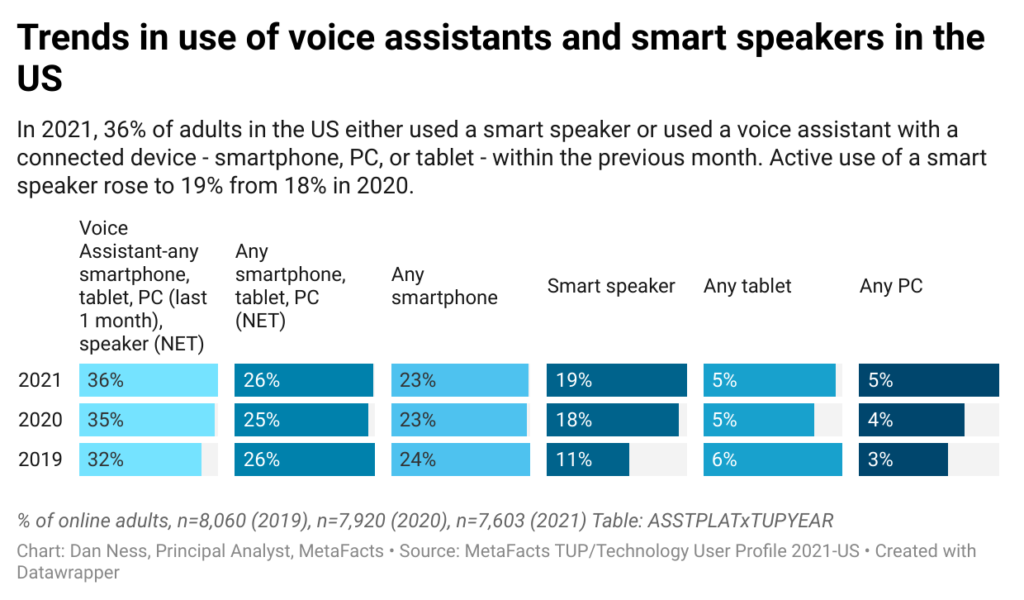Work-related video calls had been growing in use even before the pandemic. Platforms such as Apple Facetime, and video calling services within Microsoft Teams and Zoom helped them come into regular use, even while employees have many other ways to communicate – email, text, and collaboration platforms like Slack and Microsoft Teams. Nearly between 30% and 46% of employees in the US, UK, Germany, and Japan regularly use one of their connected devices to make or receive work-related video calls. This MetaFAQs reports on the number of employees regularly using their connected devices for work-related video calls, detailing each device type used – smartphone, home PC, work PC, or tablet – by the size of their employer – <20 employees, 20-499 employees, or 500+ employees.
Top listening activities by device type
Around the world, tech users are listening—to their devices, at least. Smartphones dominate listening activities, but many other devices, like PCs and tablets, also play a role. This MetaFAQs profiles all online adults who actively use their connected devices for specific listening & hearing activities. The report details which activities are being done by platform, showing how computers are used differently from smartphones or tablets. Active listeners number 209 million in the US (95% of online American adults), 54.6 million in Germany (94%), 44.2 million in the UK (94%), and 78.1 million in Japan (87%). Report [TUP_doc_2022_0129_list] in TUP Lenses: Consumer Electronics; Activities; Wearables, Hearables, Listening, and Speaking; Home Entertainment.
How Americans use devices in technology ecosystems
Technology ecosystems can be called truly unique when users actively use them differently than others. This TUP analysis reviews the activities American adults regularly do with their smartphones, computers, and tablets. It reports on the top 10 activities that are the most unique by ecosystem family – Windows, MacOS, ChromeOS; iOS and Android; and iPadOS and Android. Unique activities are defined as those with the widest range of use, where the difference is widest between the usage percentage between each given operating system family.
How often are voice assistants being used?
Are voice assistants such as Apple Siri or Amazon Alexa in as widespread usage as imagined? How recently have online adults in the US, UK, Germany, and Japan used a voice assistant? How does voice assistant use compare when using a smartphone versus a computer? Between 26% and 38% of online adults in these countries have used a voice assistant with a smartphone, and between 10% and 13% used a computer. This MetaFAQs reports on the recency of voice assistant usage among online adults in the US, the UK, Germany, and Japan. It further splits smartphone and computer usage by the age group of Americans.
What are the major listening activities across countries?
Who’s listening? And to what? Most online adults report having used any connected device for specific listening and hearing activities within the previous month (ranging from 87-95% of online adults, depending on country). Regularly making personal phone calls dominates as the most popular listening activity in every country surveyed, and video calls have reached the halfway mark.
This MetaFAQs reports on listening activities (including phone calls, videos/movies, video calls, music/radio/podcasts, television, video games, video meetings, voice assistants, and voice memos) by country: the US, UK, Germany, and Japan in 2021.
Profile of voice assistant users
Using our voice offers the chance to get things done without typing when using a smart speaker or another connected device – smartphone, PC, or tablet. However, current usage has not reached even half of the population. This MetaFAQs reports on the percentage of online adults in the US, Germany, UK, and Japan that regularly use a voice assistant or smart speaker, detailed by age group.
Game console use among socioeconomic groups
Just over one-third of online American adults regularly use a game console. Penetration rates vary widely between socioeconomic groups, with American IT employees having some of the highest rates and seniors aged 75 and higher having some of the lowest. This MetaFAQs reports on the penetration of game consoles by major socioeconomically advantaged and disadvantaged groups.
Highlights: Devices
There has been a sea change in which connected devices people use as well as how they use them. This TUP Highlights report details the trends in device ownership, the shifts between technology ecosystems, and market penetration levels. It spells out the major activities for each type of device, and how usage has changed. Furthermore, it details how many employees use personal devices for remote work.
Online banking among socioeconomic groups
Using smartphones, PCs, or other connected devices for online banking is widespread, but not ubiquitous. Fewer American adults with lower income or less educational attainment use online banking than those with higher income or technically savvy. This MetaFAQs reports on the active usage of online banking among socioeconomically disadvantaged and advantaged groups, each defined by a combination of household income, educational attainment, homeownership, ethnicity, age, employment status, racial/ethnic identity, and other factors.
Breadth of voice assistant usage
Dan Ness, Principal Analyst, MetaFacts, December 13, 2021
Actively using a voice assistant or smart speaker
- This analysis focuses on those people who are actively using a voice assistant or smart speaker
- Have used a connected device to use a voice assistant within the previous month
- Smartphone, PC, or tablet
- Have a smart speaker
- Have used a connected device to use a voice assistant within the previous month
- Base: all online adults
Active voice assistant usage by platform – US
- The overall use of a voice assistant or smart speaker has only slightly increased between 2019 and 2021
- Smart speaker usage has grown the most among American online adults, rising from 11% in 2019 to 19% in 2021
- Voice assistant usage with other connected devices has not changed markedly
- Voice assistant usage with a smartphone continues to outpace smart speaker use


